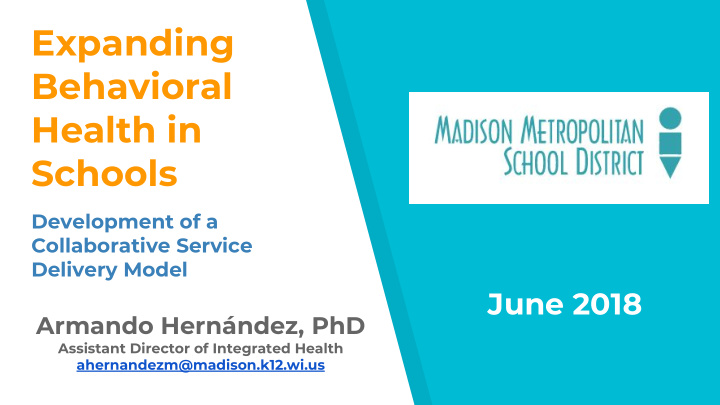



Expanding Behavioral Health in Schools Development of a Collaborative Service Delivery Model June 2018 Armando Hernández, PhD Assistant Director of Integrated Health ahernandezm@madison.k12.wi.us
AGENDA Today’s Objective 1. Introduction 2. Overview of BHS Develop an ● understanding of an 3. Model & Principles emerging Collaborative Service Delivery Model 4. Service Delivery Reflect on what are the ● 5. Implementation next steps for your 6. Improvement context or program.
The Why, Vision, 30k ft View PUrpose The What, Strategy, 1k ft View Priorities The How, Plan, Ground Implementation
CHILDREN’S MENTAL HEALTH COLLABORATIVE Dane County, Wisconsin Click here for presentation https://www.schoolmentalhealthwisconsin.org/school-based-mental-health/
School District & Agency COLLABORATION School-Based COORDINATION Admin Leads Coordinator Integrated Team Student BHS & Family Clinician TREATMENT .5 Allocation
Madison BHS Model* 1. MH Clinician is Integrated a. Close collaboration with coordinator and school staff. b. Member of a student services team c. Flexible alignment with “school culture” d. Part of tiered system of supports 2. Guided by a community-based partnership (MOA) 3. Service delivery guided by 4 guiding principles: family-based , trauma-informed, culturally responsive, data driven 4. Seeks innovation & sustainability
4 Guiding Principles Family Culturally Trauma Data Based Responsive Informed Driven ● Effective ● Engagement ● Screen ● Plan ● Capacity ● Involvement ● Practices ● Outcomes ● Context ● Empowering ● Impact ● Monitor ● Systemic ● Strengths ● Partnerships ● Improvement
Service Delivery Model Implementation Referral Delivery of Pathway Service Foundation
Service Delivery Model Clear set of activities ❏ Implementation Follow stages ❏ Focus on implementation drivers ❏ All activities (Eval, Tx, Care Management) Delivery of ❏ consistent with the four guiding principles: Service family-based / trauma-informed / culturally responsive / data driven Referral Criteria ❏ ❏ Selection Pathway Parameters ❏ Orientation ❏ MOA/partnership Teaming/Roles ❏ ❏ Foundation Coordination Four principles ❏ ❏
Service Delivery Model Implementation “... a specified set of activities designed to put into practice an activity or program of known dimensions. … processes are purposeful and are described in sufficient detail such that independent observers can detect the presence and strength.” https://nirn.fpg.unc.edu/learn-implementation/implementation-defined
https://implementation.fpg.unc.edu/ Search for “NIRN Implementation”
“Enabling contexts … refers to the system in which organizations provide services to people. ... The goal is to assure that the structures, roles, and functions within a system are more enabling than hindering in their impact on the services provided and the degree to which socially significant outcomes can be achieved.” https://nirn.fpg.unc.edu/learn-implementation/systemic-change
Collaborative Processes ▸ Teaming ▹ School-based Team ▹ Cross-School Coordinator Teams ▹ District-level Lead Team ▹ Partnership Core Team ▸ Clear vision: 30k, 1k, Ground ▹ District as fiscal agent ▹ Driver of program design? Both/And ▸ Community-wide Impact (CMHC)
Service Delivery Continuous Improvement Nurture the ‘leadership driver’ for implementation ▸ Easy: BHS as fragmented tier 3 program ▹ Hard: BHS as part of integrated/tiered system ▹ Matching allocation to need: flexing .5 model ▸ Progress monitoring: flexible/dynamic process for ▸ closing or transitioning to tier 2 Minding the gap between four principles and ▸ implementation
1) Share your impressions and reactions of what you have heard. 2) What questions or wonderings come up for you?
Recommend
More recommend